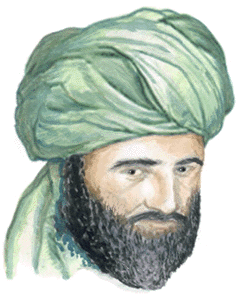...Best of Sicily presents... Best of Sicily Magazine. ... Dedicated to Sicilian art, culture, history, people, places and all things Sicilian. |
by L. Mendola and V. Salerno | |||
Magazine Index Best of Sicily Arts & Culture Fashion Food & Wine History & Society About Us Travel Faqs Contact Map of Sicily
|
According to the contemporary Spanish Arab traveller Ibn Jubayr (1145-1217), Idrisi's Hammudi family was influential among Sicily's Muslims, and Idrisi's fame as a man of letters was known before his invitation to the court of King Roger II. He arrived in Sicily around 1145, and may have first visited as early as 1139. Idrisi produced a number of works based on astute scholarly research, and it has been observed by modern Arabic scholars that Idrisi was an exceptional poet and writer of Arabic prose. His famous planisphere, a large global map made of precious metal (mostly silver), did not survive the twelfth century, but it is known to have been a noteworthy work of geography - probably the most accurate map of Europe, north Africa and western Asia to have been created during the Middle Ages. An atlas produced during this period survived, and has been published in Germany and Iraq. A multilingual "Book of Drugs" is also known to us. A minor geographical treatise written during the reign of Roger's successor, William I, has been lost to time. His greatest surviving work is, without doubt, his "Pleasure Excursion of One Eager to Traverse the World's Regions," better known as the Book of Roger. Much of the information is secondhand. He describes England's dreary weather, for example, but we know not whether Idrisi ever set foot in that country. (England, like Sicily, was a Norman realm, and there was anyway much contact between the two kingdoms.) Closer to home, the book provides much information about Norman Sicily's economy. In a casual observation, Idrisi mentions the making of spaghetti in Trabia. It is to Edrisi that we owe much of our knowledge of the entire Mediterranean. Some of the book's statements were revolutionary for their time, things like "the earth is round like a sphere." Today, the Book of Roger is considered one of the most important scientific works of the Middle Ages. That was not always the case among Europeans. Praised by Sicily's Muslims, Jews and Orthodox ("Eastern") Christians, the work was not generally appreciated by the medieval popes or the Roman Catholic clergy, and for that reason its knowledge was sometimes suppressed in western Europe. Like Marco Polo, Edrisi was a traveler who wrote about what he saw, but his work was much more scientific, and generally more objective, than Polo's. More importantly, it survives in its original manuscript form; Marco Polo's writings exist primarily as later transcriptions which were often altered. Eurocentric historians who long considered medieval times to have been Europe's "Dark Ages" overlook the developments of the Arab and Byzantine worlds that touched Norman Sicily, where scholarship and the arts flourished in a manner then unknown in most of northern and central Europe. In such a world, Palermo assumed its place as a centre of learning and expression alongside Cordoba, Byzantium, Alexandria and Baghdad. Idrisi's accomplishments were part of this trend. The Book of Roger was completed early in 1154, shortly before the death of the king for whom it was named. We know little of Idrisi's life afterward. The court geographer must have been disappointed to learn of the theft of his planisphere during looting by some rogue Norman nobles in 1161. The revolt bore the marks of "European" Sicily's embryonic anti-Arab sentiments. Abdullah el Idrisi died around 1166, either in Sicily or in Morocco. About the Authors: Luigi Mendola is the History Editor of Best of Sicily and author of several books. Palermo native Vincenzo Salerno, who contributed to this article, has written biographies of several famous Sicilians, including Frederick II and Giuseppe di Lampedusa. | ||
Top of Page |
 Abu Abd Allah Abdullah Muhammed ibn Muhammed ibn Ash Sharif al Idrisi (or Edrisi) was born in Sabtah (now Ceuta), Morocco, around 1100, descended through a long line of distinguished and aristocratic personages from the Muslim prophet, Muhammed. (The painting shown here is speculative; there are no known, accurate depictions of Idrisi, and medieval Islam generally discouraged the portrayal of humans.) It is possible that his family was traditionally associated, perhaps through commerce, with Sicily's northwestern emirate, with its capital of Bal'harm (Palermo), and Idrisi certainly had kin in Sicily. His immediate ancestors were the Hammudids of the caliphate of Spain and north Africa, a branch of Morocco's Idrisids, and it was at Cordoba and Marrakesh that Idrisi's earliest education took place. He eventually visited the Holy Land and Asia Minor, as well as parts of France and possibly England.
Abu Abd Allah Abdullah Muhammed ibn Muhammed ibn Ash Sharif al Idrisi (or Edrisi) was born in Sabtah (now Ceuta), Morocco, around 1100, descended through a long line of distinguished and aristocratic personages from the Muslim prophet, Muhammed. (The painting shown here is speculative; there are no known, accurate depictions of Idrisi, and medieval Islam generally discouraged the portrayal of humans.) It is possible that his family was traditionally associated, perhaps through commerce, with Sicily's northwestern emirate, with its capital of Bal'harm (Palermo), and Idrisi certainly had kin in Sicily. His immediate ancestors were the Hammudids of the caliphate of Spain and north Africa, a branch of Morocco's Idrisids, and it was at Cordoba and Marrakesh that Idrisi's earliest education took place. He eventually visited the Holy Land and Asia Minor, as well as parts of France and possibly England.